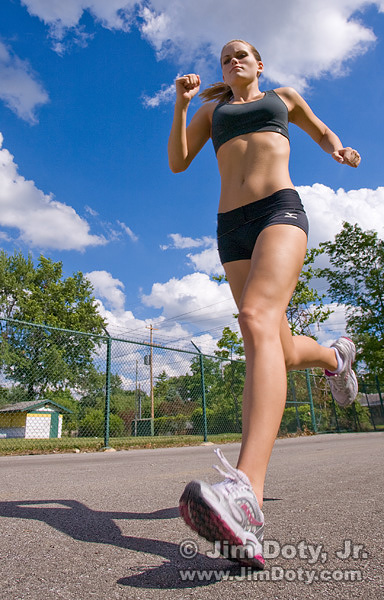Most photos are taken from eye level, so you can give your photos a dramatically different look by putting your camera on the ground.
I needed a photo of a runner for my book, Digital Photography Exposure for Dummies. I used two focal length extremes, shooting at 400 mm and 17 mm. For the 17 mm photos the camera was on the ground which provides an unusual perspective. If you pay careful attention to camera angles during movies, TV shows and commercials, you might be surprised how often the camera is on the ground. (The real purpose of TV commercials is for photographers to study composition, lighting, focal lengths, camera angles, framing, and perspective.)
We picked a blue sky day with white clouds, and we met late enough in the afternoon to have a nice shadow. With the camera on the ground, I was laying on the ground with my face was literally in the dirt so I could see through the viewfinder. The 17 mm focal length gave me a super wide angle field of view. To get the photo I wanted, Jet’s left foot needed to land about 12 inches from my camera lens, plus I had to get the timing right. She ran by numerous times until we got exactly the photo we both wanted.
In bright sunlight, Basic Daylight Exposure (BDE) gave several possible exposure combinations. At 17 mm, an aperture of f/8 gave me enough depth of field. A shutter speed of 1/500 second was fast enough to freeze the motion of most of Jet’s body but allow for a little blurring of her left foot. To freeze her foot, I would have used an ISO of 400 and a shutter speed of 1/2000 second.
More information on BDE, aperture, shutter speed, and ISO combinations, and a lot more can be found in my photography book.
Photo Data: Canon 5D, Canon EF 17-40mm lens at 17 mm. f/8, 1/500. ISO 100.

